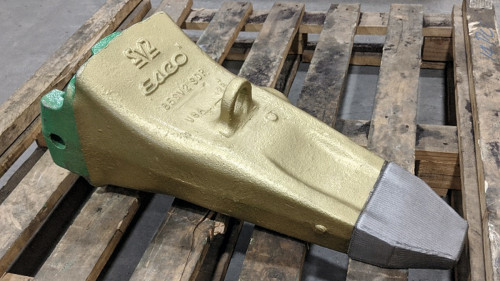Additive processes are gaining ground on conventional production techniques: they are already more flexible, more economical and more functional. Only productivity is still a problem. A German-Canadian consortium is now tackling this with artificial intelligence (AI): Using new process control software, the aim is to automatically optimize laser cladding and make it considerably more productive.
Coating wear parts more efficiently and adaptively
Canadian machine manufacturers receive many orders from the mining and oil industries. Stone crusher teeth from the mining industry, for example, are regularly overhauled. With laser material deposition (LMD), new layers are applied to the worn part until the target geometry is achieved again.
The catch is the uneven wear. This means that layers of varying thickness have to be applied. An operator must therefore measure after every coating or at least after every 10th layer and adjust the process control.
A German-Canadian consortium has set out to automate control processes like this. In the project "Artificial Intelligence Enhancement of Process Sensing for Adaptive Laser Additive Manufacturing, AI-SLAM for short", the partners are jointly developing software for system manufacturers that can be used to run LMD processes automatically. The geometries are automatically recorded during the application process. The system detects deviations from the specified contour and adjusts process parameters such as the feed rate.
The optimized control parameters are determined with the help of artificial intelligence. The software analyzes a large amount of data and independently learns how the process can be iteratively improved. The most recent milestone in the three-year project was the commissioning of the software functionality for scanning components and automatic path planning at the Fraunhofer ILT facility.
German-Canadian collaboration for more AI applications
 In the case of complex geometries such as this bucket tooth or uneven wear, AI-based process optimization will enable significant efficiency gains On the German side, the Fraunhofer Institute for Laser Technology ILT in Aachen and the software developer BCT from Dortmund are involved in AI-SLAM. In Canada, the project is being coordinated by the National Research Council NRC. A team from McGill University (Montreal) is responsible for the research side, while the Calgary-based company Braintoy is involved in programming the machine learning algorithms. Apollo Machine and Welding Ltd in Alberta is involved in the project as an industrial service provider for the LMD.
In the case of complex geometries such as this bucket tooth or uneven wear, AI-based process optimization will enable significant efficiency gains On the German side, the Fraunhofer Institute for Laser Technology ILT in Aachen and the software developer BCT from Dortmund are involved in AI-SLAM. In Canada, the project is being coordinated by the National Research Council NRC. A team from McGill University (Montreal) is responsible for the research side, while the Calgary-based company Braintoy is involved in programming the machine learning algorithms. Apollo Machine and Welding Ltd in Alberta is involved in the project as an industrial service provider for the LMD.
The focus of the project is quite complex: as much process data as possible must be systematically recorded and processed. Complex routines then learn automatically from this data how process control can be optimized in order to ultimately produce more with less effort.
On the Canadian side, LMD technology is being further developed for repair users such as Apollo. The company uses several tons of material every year to repair wear parts such as the stone crusher tooth. The expectations for efficiency gains through automated process control are correspondingly high.
Project work across both continents functions smoothly thanks to regular video meetings and jointly prepared online documents. Virtual laboratory tours to familiarize the participants with each other's software and hardware environments have also already taken place. To exchange process data and implement the machine learning models, Braintoy has activated its own web platform called mlOS (Machine Learning Operating System) for all project partners.
The AI-SLAM project will run until March 2024 as part of the 3+2 funding program with Canada. The program is funded on the German side by the Federal Ministry of Education and Research and on the Canadian side by the National Research Council of Canada NRC. The focus is on the use of artificial intelligence for the development of new technologies in industrial production. The individual projects come from a wide variety of sectors. Applications range from mining and energy to the automotive and telecommunications sectors, construction and infrastructure management.
Wear parts such as this stone crusher tooth with an outer diameter of around 140 mm are restored using the LMD process.
AI will be used to optimize the processes for repairing irregular surfaces.


